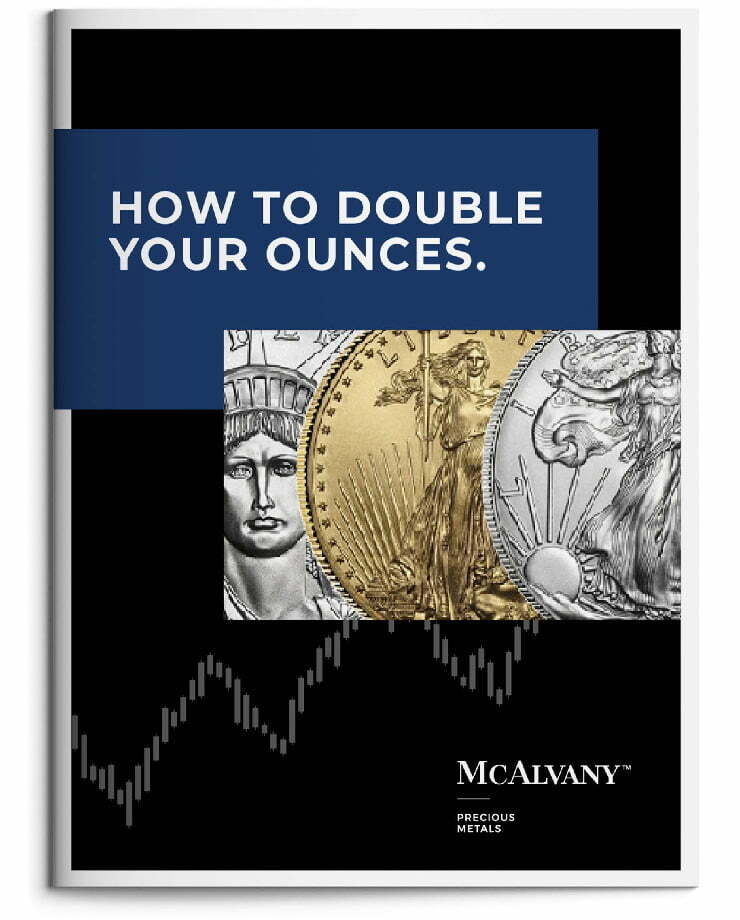Podcast: Play in new window
- Median Age Of Renter Is Now 42, Up From 33
- Trump Will Get A Victory Lap If He Cuts Middle Class Taxes
- Strong, Long-Term Holding Gold Buyers Dominate Market
“I think Trump gets his victory lap if he can aid middle-class taxpayers with cuts, social security becoming tax-free, the extending of cuts already in place. These things would be very helpful to the middle class, and potentially offset a significant portion of the next inflationary increase. But asset classes remain very vulnerable to a second thrust higher from inflation. So the difference between the middle class worrying about income and how far their money goes versus what their balance sheet looks like, I think that’s where the balance sheet is particularly vulnerable. From a valuation perspective, the stock market today is set to deliver the worst returns on record over the next decade.” —David McAlvany
Kevin: Welcome to the McAlvany Weekly Commentary. I’m Kevin Orrick, along with David McAlvany.
David, if I look back, my wife and I, when we first got married we were quite young. I mean I was 20 when we got married, and we initially bought our first place with a little bit of help from our parents as far as the down payment goes. And what we’ve tried to do is we’ve tried to progressively own a little larger place—up to the point that the house we’ve been in now we’ve been in almost 30 years, and we’ll probably at this point have to start downsizing—but that was the idea. All of the people that I knew, that’s what you did. You built, you built, you built, and then you downsized. And what that did was that opened up the opportunity of possibly having a nest egg when it comes time for retirement. It feels like that’s changing.
David: Yeah. A mortgage allows you to over time build that nest egg through almost like a four savings program. Yes, there’s the debt that’s associated with it, but as you retain some equity, assuming that the value of the house is stable or moves higher, it’s pretty remarkable. Zillow reported last week, the median age of a renter is now 42 years old—
Kevin: Wow.
David: —up from 33 years old just three years ago.
Kevin: That is incredible. So renting in your 40s, that seems to be the new way.
David: Shocking to me, but not surprising given the affordability of housing. So confirming an affordability crisis in real estate, the Zillow stats suggest we are creating a generation that is far less likely to see the net worth bump and liquidity bump in retirement years from converting home equity into a larger retirement nest egg, kind of topping it off and then converting it to an income-producing asset. Maybe it’s bonds, maybe it’s mutual funds, maybe it’s something else. That is typical in investors’ life cycle. Buy, gradually pay off the mortgage. If real estate values have increased, you have an appreciated asset that is larger than you need as your family matures and moves out, allowing you to convert the home equity into a retirement nest egg additive.
Kevin: It just goes to show we’ve heard people say, “Well, someday you’ll own nothing and you’ll be happy about it,” but we’re seeing that trend right now. I mean with where people live or even music, Dave. In the old days you would download something, you’d have a CD or you’d download it and you’d pay for it and you’d have it. Now every time you try to listen to something, I was trying to listen to Beethoven’s 6th Symphony the other day. I own it. I know it’s somewhere on the iPod or it’s on the iPhone, but they just wanted to sell me a subscription. They don’t want me to own anything.
David: That’s right.
Kevin: They just want me to renew and rent everything.
David: Yeah, rent the song.
Kevin: Everything.
David: Well, the ramp up in real estate prices has been beneficial to current owners, but it’s locked out a generation from home ownership, and it’s creating over time a greater reliance on Social Security, creating a different kind of what I would describe as social insecurity. At the same time, there is sort of a universal consensus among a sub-40 crowd that that system, Social Security, will never meet their needs, even it it exists by the time they’re mature enough to collect it.
When I think about a phrase we used a few weeks ago, financial nihilism, I see the real estate bubble and I see the single-family home inaccessibility as a key contributor to enhancing the cynical and nihilist assumptions that feed things like zero days to expiration options trading, cryptocurrency crapshoots, and other forms of highly speculative gambling, and you can almost hear under their breath, why not? We’re screwed anyways.
Kevin: Hopelessness.
David: Yeah. And it’s what you would hear under the breath of a generation of left-behinds. And, again, I’m generalizing of course, but sports betting and options trading and crypto, they share a theme in a particular age cohort of desperation to catch up financially, and I would suggest a part of that is symptomatic of real estate unaffordability and a compulsion to make up for it where you think you can.
Kevin: Do you remember when we went to Washington DC right in the depths of that recessionary time after the global financial crisis, and you and I were walking the streets where you had a lot of the ambassadors’ homes and we realized, everywhere else you went in America there was a depression or a recession feel.
David: Not in DC.
Kevin: But in DC, because everyone was on the guaranteed dole, real estate really never corrected. I wonder if that’s going to change.
David: Impossible to get a table even midweek without multiple days’ notice if you’re going out to dinner at night. I mean, just—
Kevin: The money never changed, the flow of money never changed.
David: So given the quantity of government layoffs, the buyouts and such, this is an area of real estate that may have a once in a generation retrenchment. DOGE, the Department of Government Efficiency, is gutting the administrative state, and the DC metroplex will feel it more than probably any other area. Yeah, when we were there, I mean up until recently, long considered recession proof. DC is entering a new age. Residential real estate, and that’s not only there, it’s commercial real estate as well, both are likely to be under acute pressure in DC, and it combines top down from DOGE and bottom up from unemployment squeeze. DOGE is already calling leases, 7,500 federal office building leases are already being cut.
Kevin: Wow.
David: 7,500 nationwide. And the pace of lease cancellation is expected at about 300 per day according to the General Services Administration, they’re directly responsible for managing the government office portfolio. Most DC area commercial properties are done—not like you would see if you were signing a lease for three years or five years or 10 years. A lot of your A and A+ properties, you’ll sign on for 10 or even 20-year leases. Those are really if you want to stay there, you like the properties. Most DC area properties the government leases for one year with the option to renew, which puts 2025 and 2026 as years to be the catch-down years in commercial real estate in DC as those leases lapse and the administrative state shrinks further.
Kevin: You were talking about this nihilism, this hopelessness. The inflation numbers aren’t helping because what we’re seeing, I mean already real estate’s very hard to own and of course it’s hard to even buy eggs for a lot of people, but the inflation numbers, it was no surprise, Dave, that they revised the December numbers up—I mean, political I’m sure, but these CPI and PPI numbers are coming in and they’re concerning.
David: I’d personally like to thank Shirley for our family eggs. The price has not gone up at all. I probably shouldn’t say this, it might be going up next week.
Kevin: Shirley still supplies your eggs, huh?
David: Yes, we get a couple of eggs, a couple dozen eggs a week. And so, what is it now? Over the last four years, 260, 280% increase in the price of eggs?
Kevin: Shirley’s been with the company for 30 years working for your dad.
David: Well, I appreciate that she’s got chickens. There was only a couple of months there where they quit laying. They went on strike, and I think most gals who are attending the farm, I’m not sure that those layers made it through the winter.
Kevin: So you think Shirley did a little culling like DOGE?
David: Might have been. Well, CPI and PPI were more than inconvenient truths last month. For January, they were once again higher than expected and moving away from the 2% target, which is, it’s been the trend since September’s low, that low print of 2.4%. Then we had October’s 2.6, November’s 2.7, December’s 2.9, and now January’s 3.0.
Kevin: Yeah, but didn’t they even revise the December number even higher?
David: That’s true. Yeah. December’s number was taken higher, and actually if you take out food and energy, which you would think would exaggerate the CPI numbers, but in January they’re actually disinflationary for CPI. Take out food and fuel, look at core CPI, and you’re at 3.3, not the 3.0.
Kevin: Okay. So what are some of the examples of where inflation was? Because a lot of times they count things differently than I do.
David: And for people who look at 3% and say, “Well, maybe it was a little bit higher than that,” probably, because if you were looking at your car insurance, you’re looking at an 11.8% increase, transportation plus 8, Airline fares 7.1, dairy products 6.1, car repairs 5.9. So the 3%, it’s an average. So gas utilities 4.9, rent inflation 4.2. As you can see, inflation is higher than 3% for a variety of necessities, and CPI of course is just one measure. I listened to Jerome Powell last week, and he said very clearly that the number was moving towards the 2% target. They were making great progress, and of course they have the flexibility of ignoring CPI and PPI and deferring to PCE. The beauty of having sort of a staple of statistics to refer to is you can conveniently point to one or the other.
Kevin: No, Officer, I don’t use the speedometer to see how fast I’m going. I use whatever the heck I want. The fuel indicator.
David: Well, PPI was also higher than expected in January, month-over-month plus 0.4 versus 0.3 expected, 3.5% year-over-year versus 3.35 as expected. Services increased by 4.1%, and where we’ve gotten some benefit in recent months is that goods have come down. Services have been sticky at higher levels, but goods have come down. But for the month, goods rose more than services, which had previously been the source of helping to bring the whole statistic lower.
Food and energy were also higher for PPI. Diesel, as an example, was higher by 10.4% in January, a trend that’s likely to continue under Trump in large part because I think we’re done with the strategic petroleum reserve liquidations. The draining is not going to be a benefit as it was to Biden. It won’t be to Trump. In fact, I think he’ll be adding to as opportunistically as he can. In December, PPI was revised much higher, from 0.2 month-over-month to 0.5 and from 3.3 to 3.5 if you’re looking at the year-over-year level. So core PPI revisions are actually the largest since December of 2021.
Kevin: One of the points you have made in the past, Dave, and we have to go back and remember the 1970s because it was a high inflation period of time, a lot like now, and you made the point, Dave, that inflation, we can look back at the history books on this, comes in waves. You’ll have a high inflation number and then it’ll come back down for a while. You’ll think you’re on the right track, like maybe Jerome Powell would like to wish, and then you have the next wave.
David: In some ways it’s a little bit like an illness. You’ve got something that takes you down for a few days, you recover, rebound, but you’re not fully healed. So maybe you extend yourself too much because you’re feeling better, you get out a little bit more, but you shouldn’t have. You should have stayed, you should have rested, you should have cured before and all of a sudden it comes back with a vengeance, and that second wave of illness can hurt. We know there’s added budgetary worries for consumers. So should this trend of inflation continue or rebound to the higher levels of 2021, 2022, 2023, it’ll be a concern for consumers. And history does suggest inflation comes in two significant waves. The first one’s behind us.
The charts are blind to cause, that’s really not what you’re getting when you look at that pretty picture that says, oh, here’s how it has behaved in the past. Whether it’s fiscal stimulus like we had from Trump and Biden in response to COVID, supply chain issues as a further complicating factor in that era, or, present tense, the likely inflationary pressures from tariffs, the charts would suggest a strong upward push, and that’s going to be significant and consequential to asset classes.
Bonds are vulnerable, as are stocks. Your 60/40 portfolio allocators very much move back to the cross hairs, along with a host of hedge fund strategies, things like risk parity which maintains leveraged bond exposure to offset equity risk, and sometimes both of those can work against you. It’s as if, if you were to survey asset allocators today, professional asset allocators, Modern Portfolio Theory is dying, but the investment community as a whole has just ignored the memo.
Kevin: Yeah, it’s interesting that you ask a Modern Portfolio Theory broker, which is just about everybody, “Well, what do I do when I’m worried about stocks?” “Well, you go to bonds.” And what do you do with your bonds? Well, you go to stocks. But having said that, Dave, we’re in a period of time of some amazing unexpected changes. Now I’m thinking about the war with Russia and Ukraine right now. What are the European stock markets thinking about the possibility of an agreement?
David: I think when you reflect on the vulnerability of the bond market and the stock market and the inflationary dynamics which are anything but dead, you have to look and say, well, a strong rally, a short-covering event would almost certainly accompany a peace agreement between Russia and Ukraine. I don’t know exactly what we’re seeing right now in European equities. They may reflect optimism that resolution is eminent. I mean you’ve got year-to-date returns in the 6 to 12% range between the DAX and the CAC and your larger equity markets in Europe.
It’s a stark contrast to the Brussels crowd, the apparatchiks that are being sidelined from peace talks to date that are kind of on the outside looking in as Musk, as Trump, as JD Vance are in Europe and saying, “We’re going to do things differently. You’re going to pay your fair share, you’re going to do this, you’re going to do that.” They don’t feel like practicing socialists anymore. They feel like someone is dictating to them the terms of engagement. They don’t like it, which you might expect to see some heartburn within the European equities market and quite the opposite. You’re seeing a lot of positivity, and I don’t know exactly how to read that. It’s as if the equity market’s there, it’s the end of the world as we know it, but we feel fine.
What’s not clear is whether the giddiness in the DAX and the CAC and other European markets is merely an expression of ample liquidity in financial markets, as a whole beginning to shift allocations from overvalued US equities to undervalued European stocks, or if it is truly a look through to regional peace and a curtailment of energy insecurity.
Kevin: Closer to home, one of the great tests for Trump, there’ll be a honeymoon period whether a person likes him or not, a honeymoon period with Trump until those who are being squeezed, like we were talking about, the hopeless, the people who are running out of money before the month’s over, they’re going to need a break. And I’m just wondering, does Trump have something up his sleeve right now that would give some relief to the person who’s not making their budget?
David: I think he gets his victory lap if he can aid middle-class taxpayers with cuts, social security becoming tax-free, you’re talking about a huge voter base that would definitely tip their hats, and the extending of cuts already in place. These things would be very helpful to the middle class, and potentially offset a significant portion of the next inflationary increase. But asset classes remain very vulnerable to a second thrust higher from inflation. So the difference between the middle class worrying about income and how far their money goes versus what their balance sheet looks like, I think that’s where the balance sheet is particularly vulnerable. From a valuation perspective, the stock market today is set to deliver the worst returns on record over the next decade. What gets interesting is how the market behaves in light of the amount of leverage that’s there.
Kevin: Well, if you’ve got leverage and you’re going up, it’s a nice, happy, sunny day.
David: Leverage makes everything better on the upside. The inverse is also true. Asset classes that are being leveraged face an acute risk in a down market, and the places where a lot of leverage has flowed over the last year or two, but really in the last six months in a major way. This includes your single stock favorites, the Mag-7, Nasdaq 100, the S&P 500, of course the Treasury market via the basis trade—other than a flight to safety where you could see in a very short period of time increased demand for Treasuries, and of course that would be at the short end of the curve. Even Treasuries are vulnerable. And I just would say, mind the yield curve. Maturity adds a risk you don’t want in a portfolio. Fives, tens, long-dated Treasuries, they’re going to be a problem.
Kevin: Well, Dave last week’s program talked about the tendency toward wanting to see the dollar at a lower level. The Trump administration’s really not made any bones about that.
David: Yeah, that’s the target for this administration, a restructured trade policy globally, which of necessity will take the dollar lower. Precious metals stand to benefit from that, and the big drivers of upside pricing in the metals continues to be central banks. As we noted last week, a new source of significant demand, Chinese insurers piloting a 1% allocation in their portfolios.
Frankly, the scale of that is enough to make the Western investor irrelevant in the next upswing. Ordinarily we would say, well, okay, you’re more or less in supply and demand balance in the gold market, and if the investor is negative, the price is moving lower. If the investor is positive, the price is going higher.
And that’s where all of a sudden it doesn’t really matter what the Western investor does. If I think about just that one space, the Chinese insurance company beginning what seems to us to be a small allocation, 1%, but because of the assets in question, the total quantity of assets in question, we’re talking about a significant hundreds of tons of gold.
Kevin: So you have demand that’s come in from a different area that really just sort of displaces or makes irrelevant the Western investor.
David: Yeah, and I think any added demand from the Western investor in 2025 will be like a force multiplier. Typically, the over-the-counter investment categories like the swing vote, take the balance of new supply and current demand into deficit or surplus, and you determine that short-term trend. I’m not sure the swing vote matters on the downside, if in fact you’ve replaced that demand by Chinese institutions. But the impact would certainly be more than just a small marginal one on the upside to increase prices. You’re competing for physical ounces, and the monster institutional source of demand coming out of China, those insurers, I think will be a defining factor in 2025.
Kevin: I had a great conversation with a client yesterday, Dave. We were doing a triangle update, and he’s never sold any gold back to me. And he asked me, he goes, “I know it’s still going to go up, but should I just sell you one ounce so that I can tell my wife that I bought it low and I sold it high?” And I said, “You can. It’s a good thing to do maybe just so that you see how the process works, but I wouldn’t really worry too much about having to take out your one ounce and sell it at an all-time high.” I mean he had many ounces, but he just was like, “Is it time for me to at least try to capture a profit in one ounce?”
David: Well, I think it’s a good idea if you’re thinking about what it takes to be a good seller. What it takes to be a good buyer is discipline, routine, and essentially, if you borrow from Mayer Amschel Rothschild, buy when there’s blood in the streets and sell too soon. So to be a healthy buyer and a healthy seller, you buy when no one’s buying and you sell when everyone is buying.
Kevin: So this teaches them at least how to do it when the time comes.
David: Exactly. I hear that a lot too. Investors asking, did we miss the gold market’s move? Does it makes sense to wait for allocating capital given the 2024 and year-to-date moves higher in price? Gold’s up 11%, just over that, year-to-date. Silver, 12.5%. We’re in February.
I don’t think it is too late and I don’t think you’ve missed the major moves, you’ve missed something. But if Trump has determined to re-engineer the global trade environment favoring US companies, US exports, I think gold has a layup over the next two to four years, and $5,000 an ounce fits the setup, certainly with higher prices, possible.
Western traffic is scant, and we evidence that by looking at premiums on bullion and non-bullion products alike. We look at that, and it’s supported by the gold/silver ratio still hanging out in the upper 80s and low 90s, and as evidenced by the relative lack of adoption in the precious metals miners to date by the larger broader investment community,
I think all these categories represent value at the present time, and if Trump gets his wish of lower energy costs, coming back to the precious metals miners, if he gets his wish of lower energy costs from higher US production of oil and gas—and gold prices migrate higher, your free cash flow as a story related to the miners will reach previously unimagined heights with margins increasing substantially. There’s a possibility we see not only marginal outperformance but radical outperformance in the miners.
So I look at all of those categories as evidence that Western traffic is not there yet. And in terms of the phases, I would say we’re at the beginning of the third phase. First phase is mavericks only. Second phase is Wall Street primarily, and the third phase is retail predominantly, and I’d say we’re right at the front edge of that third phase of retail buying. Where we go and how you see the asset perform— Again, the Maverick phase is the early adopter phase. The Wall Street phase is when they’re figuring out ways to capitalize on the retailers that they’ve sussed out are going to come their direction, and that’s now in the rear view mirror. Now we are in that phase where you see actually the largest percentage gains and the most volatility in price, thankfully to the upside, but it’s when the retail investor comes in. The fact that there’s no evidence of the retail investor means I think the best is yet to come.
Kevin: But the fascinating thing is, you said we don’t really even need it because we’ve got the Chinese buyers, we’ve got the central banks. But let me ask you, what about the hedge funds, because they have been participating?
David: Well, there’s a caveat there because certainly if you look at futures markets there’s some vulnerability to hedge funds that have taken some significant positions within gold futures, silver futures, and with the precious metals miners as well. So the caveat is this time that hedge funds have been active buyers in the space. In the event of a broader de-risking and de-leveraging, I don’t think your miners would be differentiated due to their fundamental strength.
Kevin: And so you could see a downturn, but the long-term outlook is much higher.
David: Yeah, but I think the forced liquidations given their highly leveraged balance sheets, if you’ve maintained some liquidity, certainly as we have, we would be opportunistic buyers.
Kevin: So thinking about higher prices, is there any possibility, or how would there be a possibility, that interest rates would come down in here?
David: Well, I think the earlier comments on inflation are particularly relevant to our debt and deficits, and of course rates fit into that schema. Higher inflation should translate to higher interest rates. Higher interest rates—except for a short-term bid for safe havens into fixed income—higher interest rates are key to US debt market standing, and by that I mean legitimacy and ultimately how they are seen by the rating agencies in terms of credibility and strength. Jim Grant’s team tallied it recently. Our national debt increased 17-fold from 1967 to 1997. If you look at a broader period of time, longer period of time, 1967 to 2025, our debt has increased 108-fold.
Kevin: Wow.
David: The quantity of debt in the system requires lower rates, but lower rates only add more fuel to the inflationary fire. So there’s a bit of a catch-22 in terms of policies and market outcomes. It’s the higher-for-longer scenario in terms of interest rates that reinforces the risk of the debt doom loop taking what is already an outsized interest component to one that those rating agencies have to address, and certainly would compromise our standing in terms of our debt credibility. We used to be the “benchmark” for risk-free rates. Don’t think that’s true anymore.
So across the board downgrades from the agencies, hypothetically, pressures rates still higher. These dynamics are the driver of lower bond prices, lower equity prices simultaneously. We come back to that modern portfolio theory where if you diversify adequately, you don’t have to worry about market risk and loss except when everything becomes correlated. And that seems to be the frailty of Modern Portfolio Theory is it doesn’t address the issues of correlation becoming one-to-one.
Kevin: Well, and correlation is just one aspect, but you brought up leverage earlier, and sometimes leverage can be shocking because you’re like, wait a second, nobody’s owning anything on a one-for-one basis anymore.
David: Yeah. Just to close out that thought on leverage, European Securities and Markets Authority record 219 billion of bets by hedge funds that are active in Europe, 219 billion in bets with just 12 billion of client assets.
Kevin: Wow. 219 billion riding on 12 billion actual equity.
David: Yeah. So if I divide 219 by 12, it implies 18 times leverage.
Kevin: Wow.
David: And so this is where you’re talking about exaggerating market price dynamics because of something that your market operators are not in control of. They may be forced to close out their positions because it’s not their money and they’re on the clock. Bloomberg reports that the same group, ESMA, European Securities and Markets Authority, in a report last year was looking at the vulnerability of a particular cohort of hedge funds, and they were employing 2,000% leverage on their bets on mortgage bonds. So that’s Europe. Okay?
Kevin: 2,000%.
David: Well, yeah. I mean it’s a good gig if you can get it. Here in the US, QRT is a hedge fund. They run 23 billion in client assets with bets in their two major funds—this is as of last year—bets in their two major funds tally to 191 billion in one fund, 121 billion in the other. Combine those, divide by 23, it’s a mere 13.5 times leverage.
Kevin: Wow.
David: Millennium, another hedge fund, far more conservative, 7.5 times leverage. Citadel, very modest, 7.2 times leverage, according to Bloomberg. Said differently, that’s 1350% leverage. That’s 750% leverage. That’s 720% of market exposure versus underlying capital. Then of course, if you want to factor in the basis trade, you’ve got operators there who are employing 40 to 75 times leverage.
Kevin: That’s incredible.Yeah, Dave, for the person who’s listening, let’s say you have a half a million-dollar house and somebody says, “Well, as long as you put that on the line, you can go bet 9 million bucks with that.” Because that’s 18 times leverage, isn’t it?
David: Yeah, that’s your collateral. So your 9 million in bets has a basis to it, but it’s a lot of market risk to take, and it doesn’t take very much volatility in the 9 million to eradicate, to eliminate, your $500,000 in equity. So things heat up. Leverage is a force multiplier to market volatility. I’m talking about the basis trade and 40 to 75 times leverage. It’s not like we have one group—
Kevin: Like Long-Term Capital Management back in the late ’90s?
David: Exactly, 1998.
—betting the farm on a “sure thing.” There are hundreds of hedge funds that aren’t hedging, as the name implies. I mean, hedge fund, wouldn’t you think that that is somehow offsetting risk somewhere?
Kevin: They’re rolling the dice.
David: They’re gambling, and they’re able to do so because of extremely loose financial conditions. On the upside, leverage is a beautiful thing. On the downside, it’s catastrophic because illiquidity dynamics and market maker constraints exaggerate the bid in a negative way as financial assets are in rapid decline.
Kevin: I read an article last week. There’s a measurement—a few things go into it—on the fragility of stocks. This article basically said we’re in one of the most fragile times. Some of these top Mag-7 stocks are showing great fragility. So when you combine that with the leverage that you’re talking about, the over-valuations in the market, and the fragility and just the volatility.
David: I think one of the things we often forget. Sometimes we— You remember the conversation we had with Joseph Tainter?
Kevin: Mm-hmm. I was just looking at that book last night, The Collapse of Complex Societies.
David: So this is dealing with more fiscal issues and how much strain a social system can be put under before people just opt out and move away.
Kevin: The more specialized it becomes, the more complex it becomes, and it becomes more vulnerable.
David: To use the structure of Chaco Canyon or one of these other civilizations as a comparison, when you introduce complexity, you’re introducing fragility. And the interesting thing is, with complexity comes an extra degree of confidence, and it’s very unfounded because of the complexity that’s attached to it.
Kevin: You know who brought that up? Chuck Yeager brought that up. Chuck Yeager, who broke the sound barrier back in the ’40s. Back then he flew P-51s and was a test pilot. He said back then you had to be able to take that plane apart and put it back together before you flew it. That’s how those test pilots at Edwards worked. But when the Challenger blew up, he was on the board looking at it, and that’s what he said. He said, “Look, there’s over a million parts that you have to look at on the Challenger. There’s not one single person involved with the shuttle program that actually understands the whole shuttle program.”
David: So just take crypto as an example. I don’t mean to be picking, but there’s not a lot of market liquidity in crypto. That’s one of the reasons why when you see a down day it’s not a 2% down day. It could be a 12 or 20% down day. I mean, the bid just disappears and there’s no one to buy. So what’s the price? Well, we’re going to wait for the first person to step in, and it could be 20% lower. So you’ve got cryptocurrency, which is not a perfectly functioning market from a liquidity standpoint, but to that you add futures that you can make on the cryptocurrencies themselves—
Kevin: And leverage.
David: —and options. These are just different layers of complexity that you’re adding to an already wonky—I mean, if it’s not fragile, let’s at least say it’s a little bit wonky on the downside. It ends up being dangerous. And just to end, I’ll draw from Doug’s Credit Bubble Bulletin, noting over the weekend, “I saw evidence this week of both ongoing liquidity overabundance and latent fragilities. I’m not the only analyst arguing that markets are broken. Markets again this week demonstrated a precarious inability to discount and adjust to negative developments. Moreover, there were unusual trading dynamics indicative of urgent position liquidations. The Nasdaq-100 had a 3.2% swing from Wednesday’s lows to Friday’s close. Nvidia swung almost 8% from Monday’s high to Tuesday’s close. The Goldman Sachs Most Short Index sank 4.62%, only to spike 6.5% from Wednesday’s low to Friday’s intraday high. The dollar/yen traded at 151.2 early Monday, jumped to 158.80 on Wednesday, before sinking back to 152 intraday Friday.”
Kevin: So what was your watchword for 2025, Dave?
David: The watchword for 2025 remains volatility. This kind of manic swinging intraday and intraweek is a hallmark of a market top. A battle ensues over bullish and bearish positioning built on what is believed to be a very sound thesis. Volatility increases until something breaks, and when it breaks, it breaks hard.
Kevin: And this brings us to gold because, all right, after doing this for 38 years, Dave, something I would’ve never imagined is gold at all-time highs and nobody in the West having any interest in it. I mean, it’s like you can hear a pin drop.
David: Yeah. The absence of retail buying in gold and gold-related assets, I think is telling. The bullish narrative in risk assets remains intact, and thus gold to the average investor remains irrelevant.
Kevin: But gold’s at all-time highs. Where’s that coming from?
David: What we’ve never seen before is the gold market trade at all-time highs with virtually no investor interest. Usually a feverish frenzy to own an asset, any asset, accompanies all-time highs. This time it’s the strong handed institutional and central bank buyer, not the eager short-term speculator eager to quickly capture a gain and flip from buying long to selling short who’s buying to hold.
Kevin: No, these are strong hands. These are people who are going to hold and hold and hold.
David: That’s right. As the world evolves—or, as some see it, devolves—from an established order to an unknown global arrangement in trade and international power, you have some big players wanting to own more and more of the asset. Meanwhile, the little guy is happy speculating on leverage. Strong hands are buying, and the scared and disoriented retail investor has yet to appreciate all that is shifting under their feet. Markets driven by fear are a sight to behold, and I expect we’ll see that in 2025.
Kevin: Well, just remember 2008, I mean, you could not get gold. Remember when we went to Zurich, you were meeting with refiners because you realized there was a supply problem. When the retail investor actually wants gold—
David: We couldn’t get enough.
Kevin: Exactly.
David: We could not meet demand. Today you can own anything you want at the best prices we’ve seen in company history. Change is often tumultuous. This is particularly so for those who are unprepared for it, and that would describe your leverage speculator, whether it’s 100%, 700%, 2000% leverage. That would describe your financial nihilist desperate to make up for lost time and lost opportunity. That would describe your Wall Street Modern Portfolio Theory-driven asset allocator. Kevin, I see a massive shift in wealth coming. I think it’s only the Maverick and perspicacious investor that stands to benefit.
* * *
You’ve been listening to the McAlvany Weekly Commentary. I’m Kevin Orrick, along with David McAlvany. You can find us at McAlvany.com, or you can call us at (800) 525-9556.
This has been the McAlvany Weekly Commentary. The views expressed should not be considered to be a solicitation or a recommendation for your investment portfolio. You should consult a professional financial advisor to assess your suitability for risk and investment. Join us again next week for a new edition of the McAlvany Weekly Commentary.
















